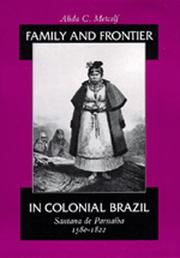| Listing 1 - 7 of 7 |
Sort by
|

ISBN: 0520075749 0585079099 Year: 1992 Publisher: Berkeley : University of California Press,
Abstract | Keywords | Export | Availability | Bookmark
 Loading...
Loading...Choose an application
- Reference Manager
- EndNote
- RefWorks (Direct export to RefWorks)
Families --- Frontier and pioneer life --- Sociology & Social History --- Family & Marriage --- Social Sciences --- History. --- History --- Santana de Parnaíba (Brazil) --- Brazil --- Rural conditions. --- Colonization. --- Family --- -Frontier and pioneer life --- -Border life --- Homesteading --- Pioneer life --- Adventure and adventurers --- Manners and customs --- Pioneers --- Family life --- Family relationships --- Family structure --- Relationships, Family --- Structure, Family --- Social institutions --- Birth order --- Domestic relations --- Home --- Households --- Kinship --- Marriage --- Matriarchy --- Parenthood --- Patriarchy --- Social aspects --- Social conditions --- -History --- Border life --- Brazylia --- República Federativa do Brasil --- Brasil --- République fédérative du Brésil --- Brésil --- Brasilien --- Pa-hsi --- Federative Republic of Brazil --- Brasile --- Brazilië --- Brazilia --- Бразил --- Федерациэм Республикэ Бразил --- Federat︠s︡iėm Respublikė Brazil --- Brasilië --- Federale Republiek van Brasilië --- البرازيل --- al-Barāzīl --- برازيل --- Barāzīl --- Rèpublica fèdèrativa du Brèsil --- Pindorama --- Tetã Pindorama --- Wrasil --- Tantasqa Republika Wrasil --- Braziliya --- Braziliya Federativ Respublikası --- Pa-se --- Pa-se Liân-pang Kiōng-hô-kok --- Бразилия --- Brazilii︠a︡ --- Бразилия Федератив Республикаhы --- Brazilii︠a︡ Federativ Respublikaḣy --- Бразілія --- Федэратыўная Рэспубліка Бразілія --- Fedėratyŭnai︠a︡ Rėspublika Brazilii︠a︡ --- Федеративна република Бразилия --- Federativna republika Brazilii︠a︡ --- Federativna republika Brazil --- Republik Kevreel Brazil --- República Federal del Brasil --- Бразили --- Brazili --- Бразили Федеративлă Республики --- Brazili Federativlă Respubliki --- Brazilská federativní republika --- Pederatibong Republika sa Brasil --- Republica Federativa del Brazil --- Republica Federale di u Brasile --- Gweriniaeth Ffederal Brasil --- Santana de Parnaíba, Brazil --- Parnaíba (São Paulo, Brazil) --- Parnahyba (São Paulo, Brazil) --- Santana do Parnaíba (Brazil) --- Brasilia --- ブラジル --- Burajiru
Book
ISBN: 9781421438528 9781421438535 1421438534 1421438526 Year: 2020 Publisher: Baltimore
Abstract | Keywords | Export | Availability | Bookmark
 Loading...
Loading...Choose an application
- Reference Manager
- EndNote
- RefWorks (Direct export to RefWorks)
How did intricately detailed sixteenth-century maps reveal the start of the Atlantic World? Beginning around 1500, in the decades following Columbus's voyages, the Atlantic Ocean moved from the periphery to the center on European world maps. This brief but highly significant moment in early modern European history marks not only a paradigm shift in how the world was mapped but also the opening of what historians call the Atlantic World. But how did sixteenth-century chartmakers and mapmakers begin to conceptualize--and present to the public--an interconnected Atlantic World that was open and navigable, in comparison to the mysterious ocean that had blocked off the Western hemisphere before Columbus's exploration? In Mapping an Atlantic World, circa 1500, Alida C. Metcalf argues that the earliest surviving maps from this era, which depict trade, colonization, evangelism, and the movement of peoples, reveal powerful and persuasive arguments about the possibility of an interconnected Atlantic World. Blending scholarship from two fields, historical cartography and Atlantic history, Metcalf explains why Renaissance cosmographers first incorporated sailing charts into their maps and began to reject classical models for mapping the world. Combined with the new placement of the Atlantic, the visual imagery on Atlantic maps--which featured decorative compass roses, animals, landscapes, and native peoples--communicated the accessibility of distant places with valuable commodities. Even though individual maps became outdated quickly, Metcalf reveals, new mapmakers copied their imagery, which then repeated on map after map. Individual maps might fall out of date, be lost, discarded, or forgotten, but their geographic and visual design promoted a new way of seeing the world, with an interconnected Atlantic World at its center. Describing the negotiation that took place between a small cadre of explorers and a wider class of cartographers, chartmakers, cosmographers, and artists, Metcalf shows how exploration informed mapmaking and vice versa. Recognizing early modern cartographers as significant agents in the intellectual history of the Atlantic.
Cartography --- Cartographers --- History --- Atlantic Ocean Region
Book
ISBN: 0292796226 Year: 2005 Publisher: Austin : University of Texas Press,
Abstract | Keywords | Export | Availability | Bookmark
 Loading...
Loading...Choose an application
- Reference Manager
- EndNote
- RefWorks (Direct export to RefWorks)
Doña Marina (La Malinche) .Pocahontas .Sacagawea—their names live on in historical memory because these women bridged the indigenous American and European worlds, opening the way for the cultural encounters, collisions, and fusions that shaped the social and even physical landscape of the modern Americas. But these famous individuals were only a few of the many thousands of people who, intentionally or otherwise, served as "go-betweens" as Europeans explored and colonized the New World. In this innovative history, Alida Metcalf thoroughly investigates the many roles played by go-betweens in the colonization of sixteenth-century Brazil. She finds that many individuals created physical links among Europe, Africa, and Brazil—explorers, traders, settlers, and slaves circulated goods, plants, animals, and diseases. Intercultural liaisons produced mixed-race children. At the cultural level, Jesuit priests and African slaves infused native Brazilian traditions with their own religious practices, while translators became influential go-betweens, negotiating the terms of trade, interaction, and exchange. Most powerful of all, as Metcalf shows, were those go-betweens who interpreted or represented new lands and peoples through writings, maps, religion, and the oral tradition. Metcalf's convincing demonstration that colonization is always mediated by third parties has relevance far beyond the Brazilian case, even as it opens a revealing new window on the first century of Brazilian history.
Indians of South America --- Conquerors --- First contact with other peoples --- History --- Brazil --- Colonization.

ISBN: 0292709706 0292712766 Year: 2005 Publisher: Austin University of Texas press
Abstract | Keywords | Export | Availability | Bookmark
 Loading...
Loading...Choose an application
- Reference Manager
- EndNote
- RefWorks (Direct export to RefWorks)
Conquerors --- Indians of South America --- History --- First contact with Europeans --- Brazil --- Colonization.
Book
ISBN: 9780292796225 Year: 2021 Publisher: Austin
Abstract | Keywords | Export | Availability | Bookmark
 Loading...
Loading...Choose an application
- Reference Manager
- EndNote
- RefWorks (Direct export to RefWorks)
Book
ISBN: 9781421403458 9781421403465 1421403455 1421403463 Year: 2012 Publisher: Baltimore Johns Hopkins University Press
Abstract | Keywords | Export | Availability | Bookmark
 Loading...
Loading...Choose an application
- Reference Manager
- EndNote
- RefWorks (Direct export to RefWorks)
Book

ISBN: 9781685855949 Year: 2022 Publisher: Boulder
Abstract | Keywords | Export | Availability | Bookmark
 Loading...
Loading...Choose an application
- Reference Manager
- EndNote
- RefWorks (Direct export to RefWorks)
| Listing 1 - 7 of 7 |
Sort by
|

 Search
Search Feedback
Feedback About
About Help
Help News
News